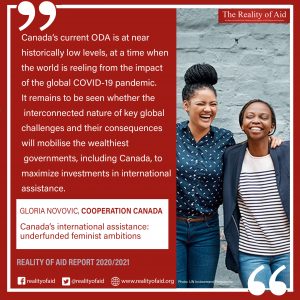Canada’s International Assistance: Underfunded Feminist Ambitions
Gloria Novovic, Cooperation Canada
Canada’s Feminist International Assistance Policy (FIAP) established the country’s donor profile as
one that is strongly supportive of human rights and trans formative gender equality efforts. However,
persistently low budgets—with Canada’s current ODA is at a near historically low levels—have
seriously hindered the effectiveness of the country’s international ambitions.
After a yearlong public consultation, Canada announced its FIAP in June 2017. Through a human
rights-based approach, FIAP positions gender equality and the empowerment of women and girls as
an intrinsic global objective and a requisite for the achievement of all other international assistance
goals. This is in line with Agenda 2030, which addresses gender equality as the stand-alone
Sustainable Development Goal 5 (SDG5) as well as through targets and indicators across other SDGs.
In adopting the FIAP Canada joins an informal global coalition of countries with a “feminist foreign
policy.” In the 2018/2019 fiscal year, Canada reportedly reached its goal of ensuring that 95% of
bilateral international assistance budget addressed gender equality as a principal or significant
objective. However, only a fraction of that funding is allocated to initiatives that directly address
gender equality (6.2% in the same fiscal year). The FIAP also targets to allocate 15% of bilateral
assistance to gender-focused initiatives.
The ambition encapsulated by the benchmark of 95%, however, leaves room for bureaucratic
“gender-washing” against which the latest OECD report warns, calling on Canada not to undermine
the integrity of the gender marker system that ranks the level of gender equality considerations in
international assistance programming.
While investments in programs addressing root causes of gender inequality are yet to materialize,
Canada is taking an important normative stance arguing for long-term, predictable, and flexible
funding to women’s rights organizations.. Canada’s deliberate focus on feminist lens has also
resulted in the development of vital policy instruments to support this framework.
Canada has continued to maintain its commitment to the most disadvantaged countries. Climate
finance, however, is an area for which civil society is advocating for increased and more diverse
funding. Canada’s climate finance portfolio should also increase its investment in projects that
address gender equality as a principal target and those that are channeled through the civil society,
which currently implements only about 7% of allocations.
Canada, as a feminist donor, has yet to articulate its strategy for effectively shifting decision-making
opportunities to local actors with intimate knowledge of local contexts and accountability to target
populations across the triple nexus. The Canadian government continues to struggle to allocate
substantial increases in its ODA to properly address root causes of key development challenges such
as climate change, poverty, and inequality. Instead, it has been encouraging alternative funding tools
to maximize the impact of its ODA.
Canada’s FIAP is increasingly being strengthened by additional policy tools, guidelines, and strategic
investments that build on sector experience on how to achieve the highest and the most
trans formative impact. However, Canada’s donor profile in many partner countries has been tainted
by a fragmented and at times incoherent foreign policy approach.
Canada’s feminist foreign policy aspirations are discredited by trade and security choices such as
arms deals that aggravate some of the direst humanitarian crises and enable human rights abuses.
Ensuring the int egrity of Canada’s missions and the coherence between its interventions across political, economic, and environmental sphere is a complex yet a fundamental requisite for Canada’s good standing in conflict affected and fragile contexts.
egrity of Canada’s missions and the coherence between its interventions across political, economic, and environmental sphere is a complex yet a fundamental requisite for Canada’s good standing in conflict affected and fragile contexts.
To craft a coherent feminist foreign policy, GAC launched consultations in October 2020. It would be
important that this policy is supported by appropriate budgetary allocations. A feminist foreign
policy would be interrogated in relation to commitments towards a more inter sectional approach.
For FIAP to be effective, Canada’s entire foreign policy must be transformed to include a coherent
set of trans formative objectives encompassing trade, diplomacy, and international assistance,
consistent with feminist principles. This will require a different narrative about Canada on a global
stage: one focused less on specific Canadian achievements and more on Canada’s role in propelling
forward a feminist agenda of progressive peer countries and integrating the perspectives of
marginalized groups in key decision-making processes on global, regional, and national scales.
